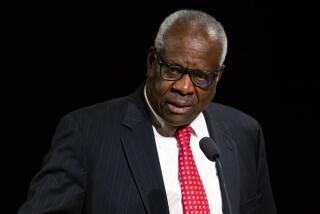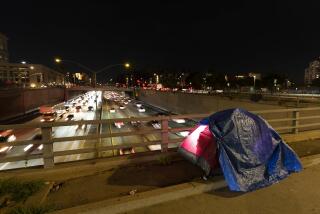High Court to Rule on Lawyer Liability in S&L; Failures : Thrifts: The government is seeking to recover bailout losses, claiming attorneys should have exposed wrongdoing.
WASHINGTON â The Supreme Court, agreeing to hear an appeal from a prominent Los Angeles law firm, said Monday that it will decide whether attorneys and accountants can be held liable for the failure of a savings and loan institution.
Government lawyers said they have pending claims amounting to more than $1.5 billion that hinge on the question. Since the collapse of scores of S&Ls;, lawyers for the Federal Deposit Insurance Corp. have sought to recover money not only from key corporate officers, but from âthird partiesâ such as lawyers and accountants.
The high court said it would decide a case brought by the FDIC against the law firm OâMelveny & Myers, in which lower courts split, on whether legal and accounting outsiders can be held liable for an S&L;âs collapse.
In several other cases, some of the nationâs biggest law and accounting firms already have paid large sums to settle liability lawsuits filed against them in thrift-related cases.
In the most notorious thrift failure, that of Charles Keating Jr.âs Lincoln Savings & Loan, three major accounting firms and three law firms paid a total of $146.2 million to settle class-action lawsuits brought by Lincoln investors.
Also, the accounting firm Ernst & Young a year ago paid the government $400 million to settle claims that its auditors failed to warn of the disastrous financial problems that triggered many of the biggest S&L; failures.
In the OâMelveny & Myers case, the U.S. 9th Circuit Court of Appeals in California dealt lawyers a setback. It ruled in June that they have a legal duty to investigate their own clients and to âadvise . . . the worldâ if a client is engaged in fraud.
Based on that rationale, the California-based appeals court revived a lawsuit against OâMelveny & Myers that grew out of the 1986 collapse of the American Diversified Savings Bank in Costa Mesa.
In 1985, the law firm had helped the two owners of the S&L; prepare an investment offer involving real estate partnerships. That offering did not disclose that American Diversified was in financial trouble.
A few months later, the S&L; was taken over as insolvent by federal regulators. The FDIC sued the two owners, Ranbir Sahni and Lester Day, for $70 million and they agreed to an out-of-court settlement.
But in 1989, the FDIC also sued OâMelveny & Myers, arguing that its lawyers engaged in legal malpractice by sanctioning the misleading investment offering.
In its response, the law firm argued that it was not aware of the fraud being perpetrated by Sahni and Day and that, furthermore, it did not have a legal duty to investigate its clients.
U.S. District Judge Terry Hatter dismissed the suit against OâMelveny in 1990, ruling that there was no legal basis for suing the law firm. But a three-judge panel of the 9th Circuit reversed his decision and cleared the case for trial.
In appealing to the Supreme Court, lawyers for OâMelveny noted that the FDIC, as the receiver, stands in the place of the defunct S&L.; Since that is so, they argued, it makes no sense to say that the S&L; can sue its lawyers for failing to discover its own fraud.
The decision of 9th Circuit, along with the FDIC suit itself, ârests largely on a transparent attempt to locate an additional âdeep pocketâ to help cover the governmentâs obligations as insurer of the bankrupt S&Ls;,â said Gregory R. Smith of the firm Irell & Manella, which is representing OâMelveny in the case.
Though the Justice Department endorsed the 9th Circuit ruling, it nonetheless also urged the high court to hear the case (OâMelveny & Myers vs. the FDIC, 93-489). It noted that government lawyers are pursuing hundreds of claims of âmalfeasance by insidersâ in the S&L; industry, and said the law needs to be clarified.
Last year, the Supreme Court ruled that outside lawyers and accountants cannot be sued for damages under the federal Racketeering Influenced and Corrupt Organizations law, but the justices left open the possibility that lawyers and accountants could be held liable under other legal theories, among them malpractice.
Should the FDIC win in the Supreme Court, the OâMelveny case would return to Los Angeles for trial. The 9th Circuit judges said the government would have to show that the firm could have ferreted out the fraud if it had exercised âdue diligence.â The FDIC has not specified how much it is seeking in damages.
More to Read
Inside the business of entertainment
The Wide Shot brings you news, analysis and insights on everything from streaming wars to production â and what it all means for the future.
You may occasionally receive promotional content from the Los Angeles Times.











